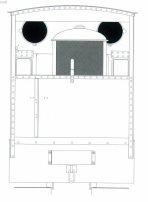


Kerr Stuart's talented development engineer Kyrie W Willans produced the design that was to lead to the production of the prototype 4415. Ordered on 5th May 1928 it was delivered to Dinas on the Welsh Highland in late July.
The current engine is a Mclaren MR4 4-cylinder diesel engine. The clutch is of the cone type, and is incorporated as part of the flywheel. The drive is taken through the clutch shaft to the gearbox at the front of the loco via a Hardy-Spicer flexible coupling. The gearbox ,which was made by Kerr Stuart had an all welded steel casing. This was one of the very first examples of fabrication taking the place of casting on a job of this kind.
The transmission consists of a chain from the gear box to the leading axle, with two further chains transferring the drive to the other axles. The axleboxes are connected by a series of turnbuckles allowing their position to be altered relative to each other thus tensioning the chain. Loads from the superstructure are transferred to the axleboxes by leaf springs.
 The wheels and gears are cast steel. The six 24” diameter wheels are all flanged, press fitted to the
The wheels and gears are cast steel. The six 24” diameter wheels are all flanged, press fitted to theaxles which run in plain bearing axleboxes. The drive sprockets are bolted on the face of the
wheel centre, with a cork axlebox oil seal running on the vertical face. The loco was designed to facilitate changes to the gauge.
The controls for the change speed and reverse gears in the straight ‘crash’ gearbox worked in quadrants on the nearside, and the long lever beside them worked the clutch. The latter could be held in the 'out' position by a foot locking pedal below it.
The dominant structural material of the locomotive is steel. Some small items are made of brass. The separate components of the locomotive are mostly pneumatic-riveted by hand. The bodywork is secured by rivets to an angle frame. Components are attached to each other by bolts secured in the main with hexagonal nuts.
Alterations
 The following changes can be identified as having taken place to the locomotive between 1928 and 2009:
The following changes can be identified as having taken place to the locomotive between 1928 and 2009:• The couplings have been changed several times.
• New, larger sandboxes have been mounted on the side of the bonnet, and the originals lowered to a new position.
• The cab front sheet, upper sides and back sheet have been replaced, along with the angle iron to steel.
• The locomotive had the original MacLaren-Benz engine replaced with the MacLaren MR4 in 1945.
• The exhaust has been replaced from two chimneys to a large silencer.
• The locomotive has been repainted several times from its original works grey to the green it now carries, which was applied when it was put on a plinth.
No comments:
Post a Comment